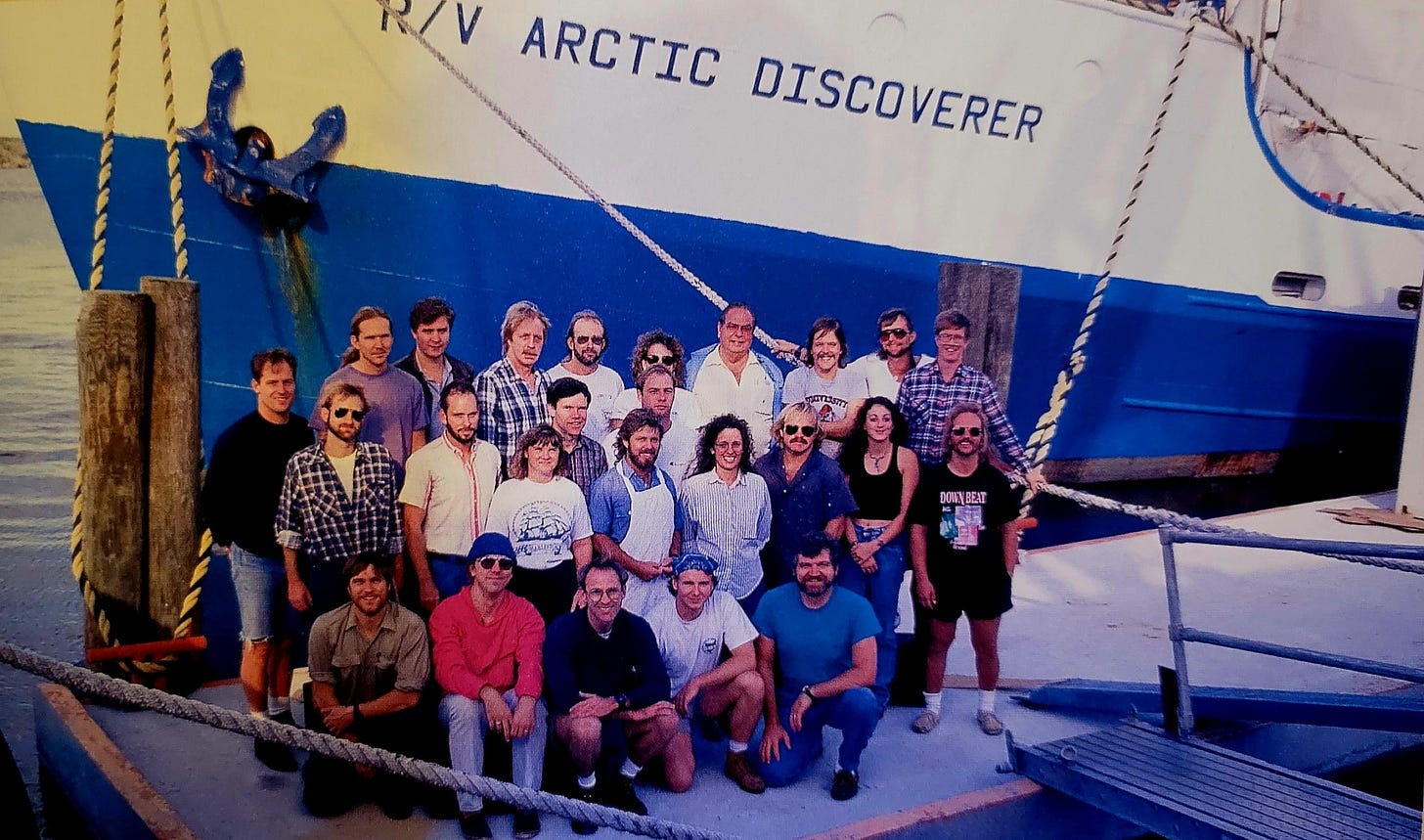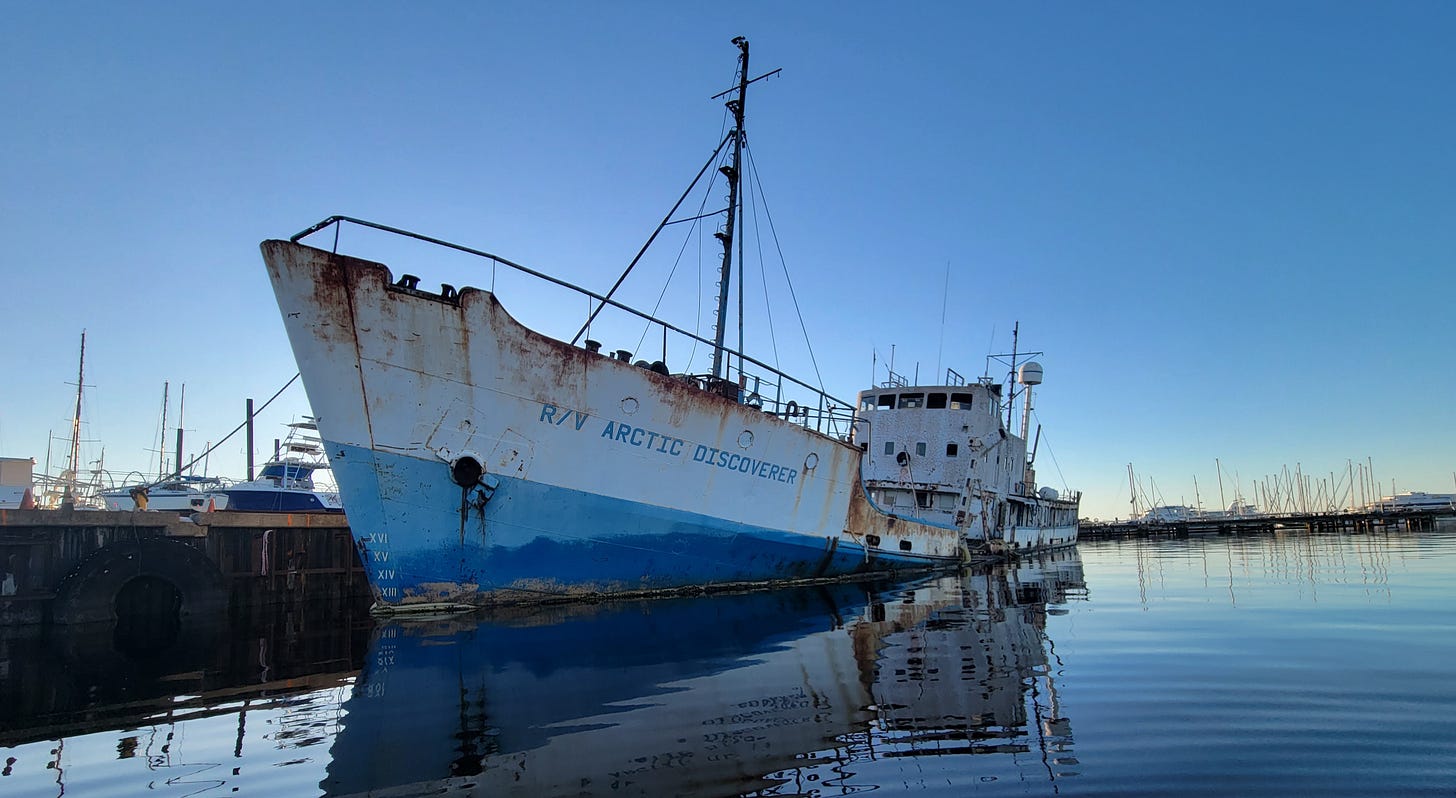Ship That Salvaged 'Ship of Gold' To Be Sunk Herself (Photos)
'Arctic Discoverer' To Become Artificial Reef off Florida, Owner Says

Like her ingenious and incarcerated former skipper, Arctic Discoverer is a treasure-hunting legend. Tommy Thompson and his merry band of technical experts performed a near miracle when they used Discoverer and a submersible named Nemo to score the biggest treasure haul in history.
In 1988, Thompson’s crew recovered three tons of gold coins and gold bars from the SS Central America, which had sunk in a hurricane off South Carolina carrying today’s equivalent of $550 million in gold. Even as recently as the 80s, the ability to find a wreck that was 8,000 feet deep and to recover its contents was something only the U.S. government might be able to accomplish.
Today Tommy Thompson rots in prison for refusing to hand over 500 of those coins, and Arctic Discoverer lies rotting alongside a bulkhead at Reynolds Industrial Park on the St. Johns River at Green Cove Springs, Florida.
But, as you read this, Discoverer’s ultimate fate is being negotiated, and it has an element of symmetry. She’s to be sunk—possibly off Jacksonville—to become another artificial reef on what was once a featureless bottom. There are already 35 artificial reefs lying off Florida’s “First Coast.”

Arctic Discoverer first came to Green Cove in 1988. After serving under different names as a Canadian government research vessel, the 180-footer was purchased by Thompson’s syndicate for $167,000. She sailed down to Florida for a refit at Reynolds.
Gary Kinder, author of the bestselling book “Ship of Gold” about the SS Central America salvage, wrote this:
At the end of the first week in April, (Thompson’s captain) sailed into Jacksonville, up the St. Johns River and had the ship on shore power dockside, Pier 7, in Green Cove Springs the evening of April 9…A crew of carpenters, electricians and day workers now had two months to transform the Arctic Ranger, old, frozen, Canadian fisheries research vessel, into the Arctic Discoverer, technologically unequaled deep-ocean recovery marvel.
Thompson’s group recovered just three tons of Central America’s gold, most of which was sold in 2000 for $52 million. The delay between recovery and remuneration was due to a lengthy but ultimately unsuccessful lawsuit to take away the loot. The suit was filed by successors to the lost ship’s original insurers.

Later, Thompson’s recovery triumph was subsumed by yet another a legal quagmire, and the ship quietly returned to North Florida. Investors had sued Thompson, saying they had not been paid. Retired Reynolds Dockmaster David Peden recalled that Thompson’s crew had brought Discoverer to the sprawling yet obscure riverfront facility to “hide her.”
The Abandoned Southeast website described what happened next:
In 2012, a judge demanded Thompson to appear in court regarding the legal cases against him. His lawyer appeared on his behalf and stated his client was at sea with no expected return date. The judge ordered U.S. Marshals to find Tommy Thompson. The R/V Arctic Discoverer was seized and sold at auction for $50,000. The buyer planned to strip the boat and sell it for scrap metal. A majority of the equipment and logs were auctioned off on eBay.

Peden, who became dockmaster in 2002 when Reynolds opened a marina on two of the piers at the former Navy base, recalled that Discoverer was already there when he came aboard. “Dockage was paid for a long time by an office in Ohio, and, when they stopped paying the Port (Reynolds) arrested the vessel and it was auctioned at the courthouse,” he said.
Tom Holland operates the Holland Marine boatyard, a stone’s throw away from Discoverer’s berth. Speaking to local TV reporters a few years ago, Holland described the ghostly scene when he stepped aboard Discoverer long after her crew had abruptly vanished.
"It looked like the crew went to lunch and never came back," Holland said. "Plates and cups on the table. Dishes in the sink."

The ship was sold a couple times more, losing bits and pieces each time, but the scrappers never got around to cutting the hull into pieces for recycling, perhaps because their timing never coincided with high prices in the metal market.
She is now property of Reynolds Park itself, having become another offbeat attraction at a facility that includes Debby Reynold’s paddlewheel steamboat replica, an enormous space shuttle fuel tank, an unusual lift-spud treasure-hunting barge, an unfinished hovercraft prototype and a giant Navy surplus amphibious landing craft.
Reynold’s management cast about for some way to dispose of the corroding wreck. Sinking her to form another artificial reef made sense, but there were two obstacles: 1. She was full of asbestos like most ships built in the 1950s and, 2. She can’t be moved until someone finds and fixes a hole or holes in the bottom.
Reynolds solved the first problem by having the asbestos stripped from the ship’s interior, according to Ted McGowan, director of Clay Port Inc., Reynold’s corporate owner.
“There are some who would scrap her, but we have others interested in making her into a reef,” McGowan said. “We are trying to find the hole in her bottom and patch it so she can be floated to a location where a group plans to prep her for sinking. They have funding and a permitted site. I am having a time getting someone to get our end of the work done. We have too much going on, but I will focus on that soon and get it done, hopefully.”

McGowan said it was too early to reveal the name of the organization in question or the permitted location.
According to the National Marine Sanctuary Foundation, Artificial reefs mimic actual coral reefs, supporting “biodiversity and healthy ecosystems by providing shelter, food, and other services to marine organisms,” a fancy way of saying that they attract fish. Which means they give humans a place to catch fish and divers something to look at on the bottom.
Albeit it beyond the reach of SCUBA, the Central America wreck performed the same function. In his book “America’s Lost Treasure,” Thompson wrote that 150 species of sea creature had been catalogued at the wreck, 12 of which were believed to have been unknown previously. One of the biggest was a female octopus with a six-foot “arm-span” and which “seemed to develop a rapport with the multi-armed Nemo as she climbed about the robot’s protruding booms and appendages.”

So, it is altogether fitting—perhaps even poetic—that Arctic Discoverer should find her grave in the same cemetery as that of Central America. Meanwhile, Thompson’s life plays out in a federal prison, where he is probably America’s longest serving voluntary inmate after seven years of stubbornly refusing to give up the last of the gold.
All Thompson has to do for his release is hand over the missing coins, though he would presumably still owe the court a thousand dollars for every day of his imprisonment as per the judge’s order.
What a story! One which can be enjoyed in its entirety by reading these two books:




